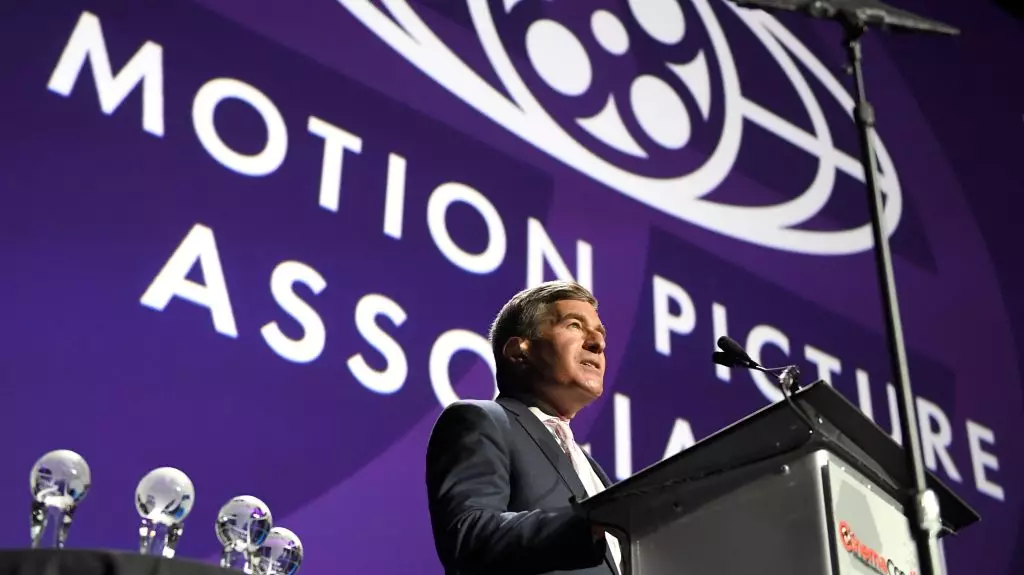The cinematic landscape is undergoing a profound transformation, with industry leaders advocating for a reinvigorated commitment to the theatrical experience. At this year’s CinemaCon, Charlie Rivkin, the President and CEO of the Motion Picture Association (MPA), emphasized a renewed partnership with theater owners, aligning his vision with that of cinema operators who collectively aspire for the rebirth of vibrant movie-going experiences. Rivkin’s impassioned plea for collaboration is not just a call for support; it’s a beacon of hope that recognizes the challenges faced in an industry wrestling with the aftershocks of the pandemic.
Rivkin stated, “We want what you want — great movies that draw big audiences to your theaters.” This sentiment encapsulates the tension that theater owners have recently felt: while they desperately need blockbuster films to fill seats, potential studio partners have frequently faltered in their commitment to exclusive theatrical releases. The pandemic brought an upheaval in viewing habits, leading to an era of hybrid releases that have threatened the traditional revenue models of theaters. Rivkin’s remarks recognize this instability and highlight a shared journey ahead, where cooperation is not just desired but necessary.
A Commitment to Theatrical Releases
Highlighting the MPA’s new member, Amazon MGM Studios, Rivkin mentioned their pledge to deliver 12-14 films in cinemas next year. This promise is more than just a numerical target; it signifies a collective effort to revive the allure of the cinema experience in an environment where streaming services have dominated consumption trends. The availability of quality content is paramount, and the theater owners are counting on the MPA to facilitate opportunities that will encourage studios to revert to traditional release models.
Yet, the question remains: can studios truly adapt to the expectations of theaters while grappling with the pressures of home-viewing conveniences? Rivkin acknowledges the uncertainty surrounding this transition, underscoring the volatility inherent in the industry’s recovery from the pandemic. The call for reformed practices is not merely a plea for nostalgia but a strategic necessity for theaters to navigate their new realities successfully.
The Economic Case for Film Production
Rivkin advocated for the economic benefits that film production brings to local communities, asserting, “A major motion picture will pump, on average, $1.3 million per day into the local economy.” This assertion is not just a statistic—it’s a reminder to policymakers that the film industry serves as a vital engine for job creation and local economic stimulation. The MPA’s ongoing campaign to engage with legislative bodies reflects an urgent need to articulate the importance of production incentives that bolster the local filmmaking economy, thus paving the way for more films to make their way to theaters.
In California, Rivkin noted the introduction of a record-setting 51 films that will receive tax credits, potentially generating approximately $580 million in economic activity. Reflecting on these developments, it’s apparent that the MPA intends to lead the charge for renewed production incentives across various states, enhancing the industry’s footprint and financial viability. Rivkin’s unwavering stance on advocacy illustrates the capability of media production not just as an entertainment medium, but as a vital contributor to local prosperity.
Looking Ahead: The Role of Collaboration
Rivkin’s vision for the future extends beyond immediate incentives; it encapsulates a long-term strategy that necessitates collaboration among all industry players—studios, unions, and guilds alike. His emphasis on enhancing federal actions reflects the ongoing battle against the strains affecting the film industry. The MPA’s proactive approach seeks not only to stabilize the theatrical landscape but also to reclaim American dominance in filmmaking—both an artistic and economic imperative.
As Rivkin stated, “When done right, incentives bring production. Production brings jobs.” This chain reaction underpins the realignment necessary for theaters to thrive and suggests that a rebirth of the cinematic experience hinges on a synergistic relationship between local economies and the global film industry. Though the road ahead may be riddled with challenges, the resounding call from leaders like Rivkin is a clarion call for hope, persistence, and partnership—essentials for fostering a vibrant future where cinema not only survives but flourishes.

Leave a Reply